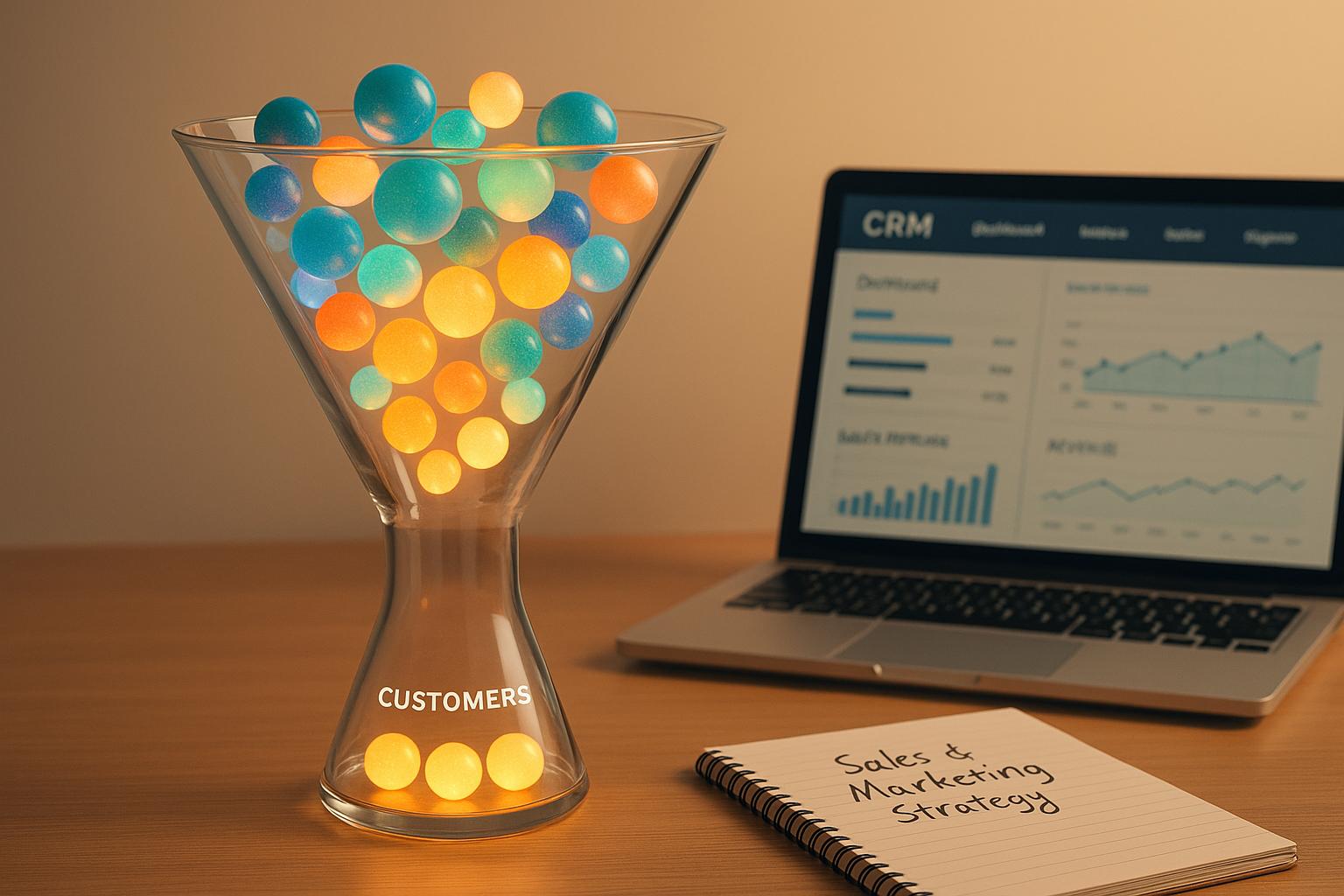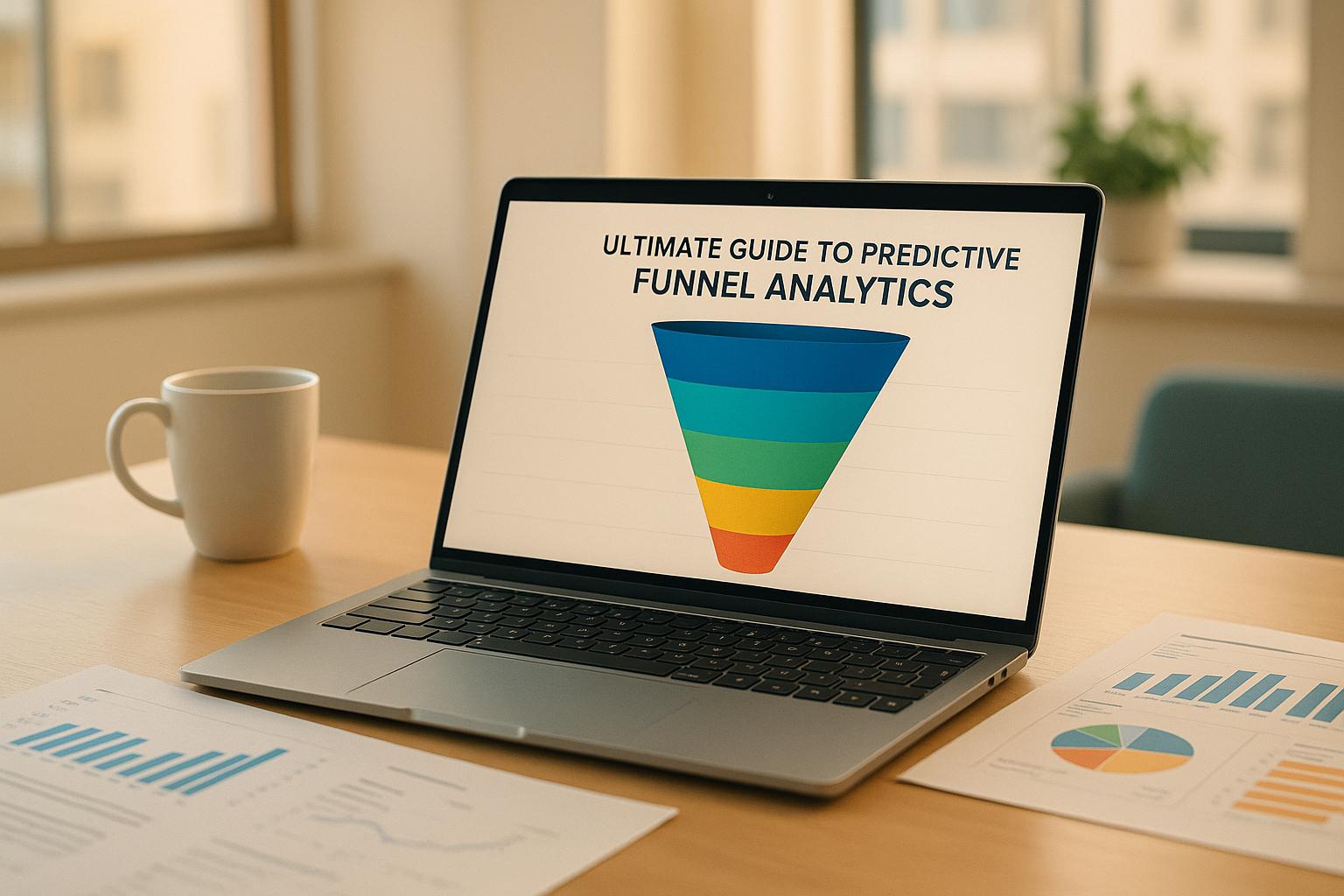Lead scoring helps sales and marketing teams work better together by focusing on the most promising leads. It assigns scores to potential customers based on their demographics, behavior, and engagement. This makes it easier to prioritize leads, save time, and improve conversions.
Here’s what you’ll learn:
- Why Lead Scoring Matters: It connects sales and marketing, solving issues like wasted time on unqualified leads and inconsistent communication.
- How to Build a Scoring System: Use factors like company size, role, and behavior (e.g., visiting pricing pages) to assign scores.
- Tools to Use: CRMs like HubSpot, Zoho, and Salesforce can automate and track scoring.
- Measuring Success: Track metrics like lead-to-sale conversion rates and ROI to refine your system.
Start by defining clear scoring rules, choosing the right tools, and fostering collaboration between teams. This ensures your resources are focused on leads most likely to convert.
Creating Your Lead Scoring System
Choosing Lead Scoring Criteria
Start by analyzing customer data to identify the main factors that lead to purchases. Look at both demographic information and behavioral patterns that align with conversions.
Here are some demographic factors to evaluate:
- Company size (e.g., annual revenue, number of employees)
- Industry type
- Geographic location
- Role of the decision-maker
- Authority over the budget
For behavioral signals, monitor activities such as:
- Requesting product demos
- Attending events or webinars
- Visiting key pages like pricing
- Downloading resources (e.g., whitepapers, eBooks)
- Engaging with emails (opens, clicks, replies)
Setting Score Values and Limits
Use a point-based system to rank leads based on their attributes and actions. Many businesses use a 0–100 scale to classify leads:
| Score Range | Lead Classification | Action Plan |
|---|---|---|
| 0–30 | Cold Lead | Share educational content to build interest |
| 31–70 | Warm Lead | Run targeted campaigns to nurture further |
| 71–100 | Hot Lead | Prioritize for immediate sales follow-up |
When assigning points, consider these factors:
- Recency: Give more weight to recent activities.
- Frequency: Repeated actions signal higher interest.
- Intent: Direct purchase signals (like pricing page visits) deserve higher scores.
- Negative Scoring: Deduct points for behaviors or attributes that disqualify a lead.
Team Input and Coordination
After defining your scoring system, ensure all teams are on the same page. Regular coordination is key to maintaining consistency. Schedule team meetings to:
- Evaluate how well the scoring criteria are working.
- Adjust point values based on the latest conversion data.
- Discuss any concerns about lead quality.
- Update thresholds for lead qualification as needed.
To keep everyone aligned, create a feedback loop. Sales teams should report on lead quality and conversion rates, while marketing teams update the process based on this input. Document everything - scoring rules, examples, and adjustments - in a shared playbook to ensure clarity across departments.
Lead Scoring Tools and Software
CRM and Automation Tools
The right software can make all the difference in tracking and analyzing prospect interactions. Top CRM platforms offer advanced scoring features to help align sales and marketing efforts.
HubSpot's CRM is a standout option for lead scoring. According to a Q3 2023 study of 250 businesses across various industries, HubSpot users experienced:
- A 20% boost in qualified leads
- A 15% increase in sales conversion rates
These numbers highlight how effective the platform can be for identifying and prioritizing high-value prospects.
Here’s a quick comparison of popular platforms and what they bring to the table:
| Platform | Core Features | Ideal for |
|---|---|---|
| HubSpot | Inbound marketing, email automation, sales tracking | Mid to large companies needing versatile tools |
| Zoho CRM | AI-driven insights, multi-channel communication, workflow automation | Small to medium businesses looking for budget-friendly options |
| Pipedrive | Simple interface, visual sales pipeline, AI analytics | Sales teams focused on ease of use |
| Salesforce | Enterprise-level automation, customizable scoring | Large organizations needing tailored solutions |
Tracking and Improving Results
To get the most out of your lead scoring system, keep an eye on these critical metrics:
- Lead-to-opportunity conversion rates
- Time from lead qualification to sale
- Score accuracy, comparing predictions to actual outcomes
- Sales team feedback on lead quality
Most platforms come with built-in analytics dashboards to track these metrics automatically. Regular performance reviews can help you refine your scoring criteria and improve results over time.
Marketing Funnels Directory Resources

The Marketing Funnels Directory is a curated resource for tools designed to enhance lead scoring and sales processes. Whether your focus is on B2B funnels, content marketing, or social media strategies, this directory can help you find the right platform for your needs.
"Pipedrive is an intuitive CRM and sales management tool designed to help businesses track leads, automate workflows, and close deals faster. With its user-friendly interface and AI-powered insights, Pipedrive streamlines the sales process for teams of all sizes." - Top Marketing Funnels Directory
When choosing a lead scoring tool, think about how well it integrates with your current tech stack. Many platforms offer APIs and pre-built connectors for popular marketing tools, making it easier to maintain a smooth data flow.
Up next, explore how to use these tools to bring your teams together for more effective lead management.
Creating an Effective Lead Scoring System for Sales and Marketing Alignment
sbb-itb-a84ebc4
Using Lead Scoring to Unite Teams
To make the most of your tools and systems, it's crucial to establish clear processes and standards that bring different departments together.
Defining Lead Scoring Criteria
A well-structured scoring system gives everyone a shared way to evaluate leads. Start by identifying measurable factors that signal a lead's readiness for sales. Here's an example of how scores can be assigned:
| Criteria | Score | Explanation |
|---|---|---|
| Company Size >500 | +20 points | Indicates higher revenue potential |
| Budget >$50,000 | +15 points | Aligns with solution pricing |
| Decision Maker Role | +10 points | Reflects purchasing authority |
| Industry Match | +10 points | Fits the target market |
Streamlining Lead Transfers
A clear process for moving leads from marketing to sales ensures nothing falls through the cracks. Key steps include:
- Setting a minimum score that qualifies a lead for sales
- Automating alerts when a lead meets the score threshold
- Sharing complete lead history, including engagement data
- Encouraging quick feedback from sales on lead quality
This kind of process ensures leads are handled efficiently and keeps both teams on the same page.
Strengthening Team Communication
Once leads are handed off smoothly, strong communication systems keep teams aligned. Here’s how to maintain collaboration:
- Hold weekly meetings to review lead quality and adjust scoring criteria
- Use shared dashboards to track key metrics like qualification rates and conversions
- Set up dedicated messaging channels for real-time feedback
These tools and practices help teams stay connected, refine their approach, and clarify responsibilities, creating a cycle of constant improvement.
Measuring Lead Scoring Results
Key Metrics to Monitor
Keep an eye on these important metrics to evaluate your lead scoring system's performance:
| Metric | Importance |
|---|---|
| Lead-to-MQL Conversion | Evaluates how well the system identifies qualified leads |
| MQL-to-SQL Conversion | Measures alignment between marketing and sales expectations |
| Sales Acceptance Rate | Assesses how effectively leads meet sales team criteria |
| Average Sales Cycle | Highlights efficiency improvements in lead management |
| Lead Response Time | Ensures timely follow-ups with qualified leads |
Instead of focusing on isolated data points, look for trends over time. Tracking these metrics on a monthly basis can help you spot patterns and refine your approach. These insights are crucial when analyzing financial outcomes.
Lead Scoring ROI
Once you’ve established performance indicators, assess the financial benefits of your lead scoring system by monitoring shifts in cost and revenue metrics. Pay attention to:
- Cost Per Lead (CPL): Compare costs before and after implementation.
- Customer Acquisition Cost (CAC): Track reductions in acquisition expenses.
- Revenue Impact: Analyze changes in deal size, win rates, and the length of your sales cycle.
To calculate ROI, use this formula:
ROI = [(Revenue Increase + Cost Savings) – Implementation Costs] / Implementation Costs x 100
Make sure to include both direct costs (like software and training) and indirect costs (such as team time and process changes) in your calculations.
Success Examples
A great way to measure success is by comparing key metrics before and after implementing lead scoring. Document improvements such as:
- Better lead quality
- Higher productivity for the sales team
- Faster lead processing times
- Higher conversion rates at each stage of the funnel
These comparisons can clearly show the impact of your lead scoring efforts.
Conclusion
Key Takeaways
Lead scoring serves as an effective way to connect sales and marketing teams. Here’s how it helps:
- Better Lead Quality: Teams can zero in on prospects most likely to convert.
- Stronger Team Coordination: Shared lead qualification processes create a mutual understanding between departments.
- Trackable Improvements: Metrics like lead-to-MQL conversion rates and sales acceptance rates show clear progress.
- Efficient Use of Resources: Sales teams focus on high-potential leads, cutting down on wasted time.
The best systems blend demographic and behavioral factors while encouraging regular collaboration between teams to fine-tune criteria based on actual outcomes. Use these principles to design a lead scoring system that works for your team.
Steps to Get Started
To build an effective lead scoring system:
- Define Criteria: Identify the traits of high-quality leads and collaborate with sales and marketing to set scoring rules.
- Pick the Right Tools: Select CRM and automation tools that support lead scoring. Check resources like the Marketing Funnels Directory for options.
- Set Clear Guidelines: Establish qualification thresholds and document them to ensure everyone is on the same page.
- Track and Refine: Keep an eye on key metrics and adjust your scoring system based on results and feedback.
Lead scoring is not a one-and-done process - it evolves. Start simple, gather data, and refine your approach over time. Open communication between sales and marketing teams, along with consistent tracking of results, will help you create a system that drives better outcomes for your organization.


